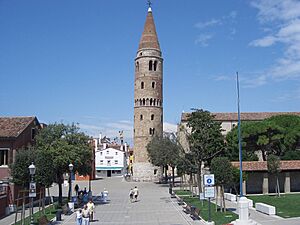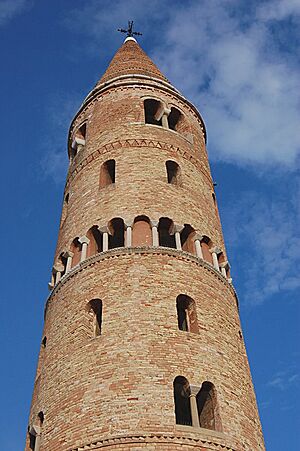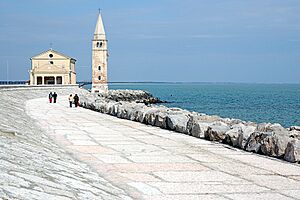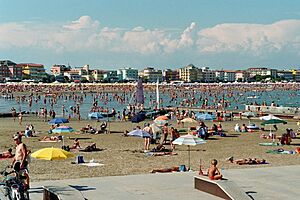Caorle facts for kids
Quick facts for kids
Caorle
Càorle (Venetian)
|
||
|---|---|---|
| Comune di Caorle | ||

Cathedral bell tower
|
||
|
||
| Country | Italy | |
| Region | Veneto | |
| Frazioni | Porto Santa Margherita, Duna Verde, Ca' Corniani, Ca' Cottoni, San Giorgio di Livenza, San Gaetano, Brian, Brussa, Castello di Brussa, Ottava Presa, Marango, Villaviera | |
| Area | ||
| • Total | 153.84 km2 (59.40 sq mi) | |
| Elevation | 1 m (3 ft) | |
| Population
(31 December 2017)
|
||
| • Total | 11,606 | |
| • Density | 75.442/km2 (195.394/sq mi) | |
| Demonym(s) | Caprulani or Caorlotti | |
| Time zone | UTC+1 (CET) | |
| • Summer (DST) | UTC+2 (CEST) | |
| Postal code |
30021
|
|
| Dialing code | 0421 | |
| Patron saint | St. Stephen | |
| Saint day | December 26 | |
Caorle is a pretty coastal town in northern Italy. It is part of the Metropolitan City of Venice in the Veneto region. The town sits right on the Adriatic Sea, between two rivers, the Livenza and Lemene. It is a popular spot for tourists, found between the towns of Eraclea and Bibione.
Contents
History of Caorle
Ancient Beginnings and Roman Times
Caorle's old name was Caprulae. This name might have come from the wild goats that lived in the area. Another idea is that it was named after a pagan goddess called Capris. Romans founded Caorle in the 1st century BC. We know this from old discoveries, like a special altar called Ara Licovia. This altar belonged to a Roman family named Licovi. Today, you can see it in the town's main church, the cathedral.
A Safe Place During Invasions
Caorle became important because it was a safe place. People from a nearby city, Concordia Sagittaria, came here for safety. This happened during a time called the Barbarian Invasions. During this period, an early Christian church was built. Some parts of it are now in the cathedral's museum.
Caorle's Rise and Fall
In the 11th century, the beautiful cathedral that stands today was built. Caorle was once home to a bishopric, which is an area led by a bishop. Over the next few centuries, Caorle grew to be one of the nine most important cities of the Republic of Venice. You can still see signs of this, like the many stone slabs from Istria used in some of the town's buildings. The town's old design, with its bridges and canals, also makes it look like a smaller Venice.
However, when Napoleon Bonaparte invaded at the end of the Republic of Venice, Caorle started to decline. The last bishop of Caorle moved away in 1807. The area that the bishop used to oversee became part of the Patriarchate of Venice in 1818. Today, Caorle is no longer a place where a bishop lives. Instead, the Catholic Church lists it as a titular see. This means it's a historical bishopric without a current bishop.
Caorle in World War I
Caorle was a very important place during World War I. It played a key role until the Italian Army began its counterattack from the Piave River.
Caorle's Landscape
Since the early 1900s, the land around Caorle has changed a lot. Most of the old forests, called "Selva Lupanica," were cut down. This made space for farms. Rivers were also given banks to control them, and marshy areas were drained. These changes created wide, flat areas with very few trees, even along the rivers.
Along the coast, the scenery is always changing. This is due to sand building up and being washed away by the sea. The landscape still feels quite wild in some parts. You can find shifting sandbanks and special fishing areas called "fishing valleys."
Main Sights in Caorle
The Cathedral of St. Stephen
The Cathedral of St. Stephen was built in 1038. It is a great example of Romanesque style. It also shows influences from Byzantine and Ravennate art. The front of the church is simple. Near the main door, you can see two carved pictures called bas-reliefs. One shows St. Agatonicus and the other St. William.
Inside, the cathedral has a main area called a nave and two side areas called aisles. Pillars and columns divide these sections. They support rounded arches. The roof is made of wooden beams. The cathedral holds many amazing artworks from the Venetian school. The most important one is The Last Supper. This painting was created by Gregorio Lazzarini, who taught the famous painter Tiepolo.
The main apse (a rounded part at the end of the church) has parts of a 17th-century painting on its walls. Above the special seat for the bishop, there is a "Pala d'oro." This means "golden altar-piece." It was given by Queen Catherine Cornaro. She found safety on the Caorle coast after her ship was wrecked. The "Pala d'oro" has six panels. Two show the Annunciation (the Archangel Gabriel and the Blessed Virgin Mary). The other four show prophets and Christ. A 15th-century crucifix hangs from the roof above the main altar.
Outside, you'll see the unique bell tower. It was built in 1048 and stands 48 meters tall. It's a typical Romanesque style, but it has a round shape. It is topped with a cone-shaped point. This makes it one-of-a-kind in the world.
Cathedral Museum
The cathedral also has a special museum. It opened on September 13, 1975. Patriarch Albino Luciani, who later became Pope John Paul I, opened it. The museum is in the old bishops' chapel. It keeps special clothes, altar cloths, and holy cups that belonged to Caorle's bishops. It also has items from Pope John XXIII. He loved Caorle because he was also Patriarch of Venice. When he became Pope, his helpers were two brothers from Caorle.
In the museum, you can see a valuable silver cross. There are also six old pictures of the apostles. These were part of an old screen called an iconostasis. Venetian artists painted them in the 12th or 13th centuries. Another important item is a silver-gold container. It is called "the most precious Blood" reliquary. People believe it holds some soil from where Jesus Christ walked before he was crucified. The museum also has the St Stephen reliquary. This holds the skull of Saint Stephen, who is the patron saint of Caorle.
Church of the Blessed Virgin of the Angel
The Church of the Blessed Virgin of the Angel is built on a small piece of land that sticks out into the sea. Long ago, the church had three main sections. But the sea kept damaging one of them. So, in the 18th century, the church was rebuilt. It now has the structure you see today.
There's a famous legend about this church. One day, some fishermen saw a bright light on the sea. When they got closer, they found a statue of the Virgin Mary holding the Child. They brought it to shore. The bishop and the townspeople tried to carry the statue to the cathedral. But it was too heavy! So, the bishop called a group of children. Because of their innocence, they were able to carry it to the nearby church of Archangel Michael. This is why it is now called the "Virgin of the Angel."
The people of Caorle deeply respect the "Virgin of the sea." Two festivals are held in her honor. One is the yearly Feast of Incoronation. During this event, there is a traditional "fire of the bell tower" with fireworks. The other is the Feast of the Virgin of the Angel. This special festival happens every five years, as wished by Pope John XXIII.
Since the church is at the end of the waterfront path, its bell tower is also used as a lighthouse.
Tourism in Caorle
Caorle is a small city, but many tourists visit it all year round. The old town center still looks like a small part of Venice. It has colorful houses, narrow alleys called "calli," and small squares called "campielli."
During the summer, many fun activities for families take place on its long beach. Other activities are organized in its lagoon. This lagoon is a type of Venetian lagoon. Here, you can still see many traditional "casoni." These were huts where fishermen used to live in the winter while they were fishing.
Notable People from Caorle
Recently, the city of Caorle gave special honorary citizenship to two important people. One was Rigoberta Menchú Tum, who won the Nobel Peace Prize. The other was Cardinal Angelo Scola, who was also the Patriarch of Venice.
See also
 In Spanish: Caorle para niños
In Spanish: Caorle para niños





